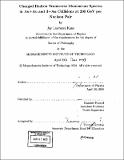| dc.contributor.advisor | Gunther Roland. | en_US |
| dc.contributor.author | Kane, Jay Lawrence | en_US |
| dc.contributor.other | Massachusetts Institute of Technology. Dept. of Physics. | en_US |
| dc.date.accessioned | 2006-03-29T18:32:37Z | |
| dc.date.available | 2006-03-29T18:32:37Z | |
| dc.date.copyright | 2005 | en_US |
| dc.date.issued | 2005 | en_US |
| dc.identifier.uri | http://hdl.handle.net/1721.1/32307 | |
| dc.description | Thesis (Ph. D.)--Massachusetts Institute of Technology, Dept. of Physics, 2005. | en_US |
| dc.description | Includes bibliographical references (p. 229-235). | en_US |
| dc.description.abstract | The Relativistic Heavy Ion Collider (RHIC) collides Au ions at a center of mass energy of 200 GeV per nucleon pair, which produces the most energetic collisions yet seen in the laboratory. RHIC has also collided proton beams and deuteron+gold beams. By studying these collisions important information about hadronic matter under extreme conditions and quantum chromodynamics (QCD) can be collected. One of the predictions of QCD is that at very high energy densities the quarks and gluons within hadrons will become deconfined and form a Quark-Gluon Plasma (QGP). These densities are thought to be achievable with Au+Au collisions at RHIC energies. Another prediction theorizes that before the collision, the very high energies of the nuclei will create a condensate of the low momentum gluons within the nuclei before any collisions occur. This condensate is termed the Color Glass Condensate (CGC). Both of these predictions can be tested by studying the transverse momentum, ..., spectra of charged hadrons produced in the heavy ion collisions. This thesis presents data on ... spectra collected using the PHOBOS detector at RHIC. PHOBOS is capable of measuring a wide range of momenta using a silicon based double armed spectrometer located in a strong magnetic field. The results show a strong suppression of a factor of 4 - 5 in the nuclear modification factor, ... at high ... as predicted in a QGP. This suppression is absent in d+Au collisions, where ... has a value consistent with unity from mid to high ... . A QGP is not expected to form from d+Au collisions, so no suppression would be expected. | en_US |
| dc.description.abstract | (cont.) When ... is calculated for different rapidities, a suppression is seen as the rapidity in the deuteron fragmentation region increases. This has been predicted to be seen if a CGC does form in the colliding nuclei. | en_US |
| dc.description.statementofresponsibility | by Jay Lawrence Kane. | en_US |
| dc.format.extent | 235 p. | en_US |
| dc.format.extent | 11662632 bytes | |
| dc.format.extent | 11678190 bytes | |
| dc.format.mimetype | application/pdf | |
| dc.format.mimetype | application/pdf | |
| dc.language.iso | eng | en_US |
| dc.publisher | Massachusetts Institute of Technology | en_US |
| dc.rights | M.I.T. theses are protected by copyright. They may be viewed from this source for any purpose, but reproduction or distribution in any format is prohibited without written permission. See provided URL for inquiries about permission. | en_US |
| dc.rights.uri | http://dspace.mit.edu/handle/1721.1/7582 | |
| dc.subject | Physics. | en_US |
| dc.title | Charged hadron transverse momentum spectra in Au+Au and d+Au collisions at 200 GeV per nucleon pair | en_US |
| dc.type | Thesis | en_US |
| dc.description.degree | Ph.D. | en_US |
| dc.contributor.department | Massachusetts Institute of Technology. Department of Physics | |
| dc.identifier.oclc | 61355070 | en_US |
